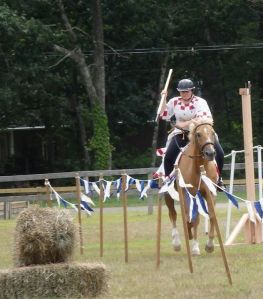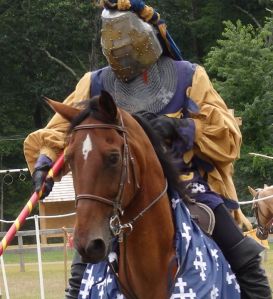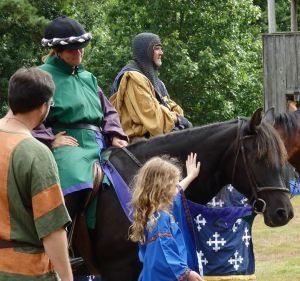What is going on here? SCA Equestrian Tournaments, explained.
The following was submitted by Mistress Eleanor Fitzpatrick as a quick “what am I looking at/for” at equestrian tournaments. Please keep these tidbits in mind when watching this Saturday’s competition (or any future Equestrian competition).
The upcoming Equestrian Champions Tournament seemed a good occasion to write this brief guide about mounted tournaments. Oftentimes it’s completely non-obvious what’s going on out on the field or why a particular competitor scored high or low, and that’s for good reason. Equestrian competition is complex and subtle in many ways, and always changing.
The first, most important, thing to realize when watching a mounted tournament is that you’re not watching a single competitor. You’re watching a team. This team consists of the rider, the horse, and often the groundcrew.
The Tournament:


Equestrian competitions change from event to event and year to year. There are several core elements that tend to show up again and again, like the quintain, rings, heads, pig-sticking and spear toss because they’re basic mounted combat or pre-jousting skills. There are elements that appear less often, either because few equestrians enjoy them, nobody owns the equipment for them, or they’re boring to watch. Each competition organizer is free to design a course however they like. They could make it all straight lines within lanes, which is easiest for the horse and allows the rider to concentrate on targeting with the weapons. They could put in lots of hairpin turns, and changes of gait and complex switching between different weapons forms. They can add a lot of tests of horsemanship, like turning the horse in a very small circle without going outside the lines, or backing up around a turn, or requiring the horse to sidepass (move sideways without moving forward). Some organizers publish the course and scoring rubrics in advance, some only give hints and some keep the whole thing secret until the day of competition. Unlike some modern sports such as dressage or reining, there is no way to know what specifically you and your horse will be asked to do, so you practice everything you can and hope for the best. Every competition starts with the organizing explaining the course and scoring to the assembled riders. Some courses are ridden completely cold, in that the course is explained but the rider can neither walk the course nor ride it before their scoring run. In those cases the first rider always has a bit of a handicap compared to the others and so many competition organizers will ride the course themselves first so that everyone has an equal chance to see how it works. Most competitions allow for the riders to warm up on the course itself so every horse has a chance to see the obstacles and the riders can get an idea of the best way to approach the course that day.

Groundcrew:

The ground crew are responsible for setting and resetting the course and for handing the weapons to the rider when necessary. In a timed course, a good groundsman who can get the weapons to the rider efficiently can make several seconds difference in the score. Of course, it’s the rider’s job to be in position and have their horse under control for the handoff, but an experienced groundsman can make that job easier. If there are not sufficient ground crew to work the field that day, the riders will take turns doing it for each other. This works well if there are multiple riders per horse so that one can be managing the horse while another is working the course, but it gets challenging as the ratio of riders to horses gets closer to 1:1. Without ground crew, it’s extremely difficult to hold equestrian competitions. Anybody can be ground crew – it’s a good way to get involved – and the equestrians are always looking for new crew as folks gain in experience and move up to becoming riders.
Rider:
The rider is the primary of the team. He or she is the one who has decided to do the competition in the first place. If it were up to the horse the competitions would be to see who could eat the most grass, or sleep the longest in the sun. Watching those would only be slightly less boring than watching paint dry. The rider is responsible both for riding the horse and for targeting with the weapons – catching the rings, hitting the heads, stabbing the hay bale. In theory, the rider is the one who decides what speed or gait they’ll be using as well. In reality, it’s a complex, ever-changing negotiation between the horse and rider. The rider may intend to do the quintain (the spinning arm) at a gallop, but the horse is tired and isn’t willing to move above a fast trot. Or the rider had originally planning to spear the rings at a trot because he or she is more accurate that way, but their horse is super excited that day and so they compromise on a canter instead of a fast gallop. Sir Alexis La Bouche from Ansteorra is fond of pointing out that SCA equestrian is 90% riding. Weapons is what the rider gets to do the the 10% of attention left over. A rider can have great hand-eye coordination and be able to spear a 2” ring with a 10’ lance easily, but if he or she leans so far to the right that the horse interprets it as a request to step sideways, they’re going to miss.

Horse:
Without the horse, there wouldn’t be equestrian competitions to watch. Horses at SCA events run the gamut from very new to very experienced, both in “mundane” training and in SCA. A horse can be very highly trained in a modern sport but be very new to the SCA, well-trained and very experienced at SCA game, very new both to being ridden *and* to the SCA, and anything in-between. At an given equestrian competition you may see everything from very experienced riders racing swiftly around the course on very fast horses to new, timid riders walking the course on calm, quiet horses. You may also see very experienced riders going slowly around a course because they’re training (or re-training) a horse who isn’t ready for speed. Speed doesn’t do any good without accuracy and control, so a good rider will work to develop both of those in a horse first. Horses are often shared between riders. Owning a horse is very expensive and bringing them to events is a lot of work, so many owners develop relationships with riders who don’t have their own horses to share the work and expense in exchange for the chance to compete. Not all horses are suitable for sharing – some simply won’t tolerate being ridden by more than “their” person, or they’re too difficult for most people to handle. The best SCA equestrian horses are even-tempered and not easily spooked, but an excellent rider can often score well even partnered with a hot-headed, high-strung horse. Horses that are calm and forgiving enough to be ridden by beginners are both rare and treasured.

The equestrians of the East try hard to balance the desire to challenge themselves at events with the desire to put on a show that will delight and entertain the spectators. Equestrian may have a high barrier to participation as a rider but everyone can watch and enjoy this little part of the Current Middle Ages just as their persona might have attended a tournament or a joust for the spectacle. Please join us at the Royal Equestrian Champions Tournament this weekend and don’t hesitate to ask questions!
